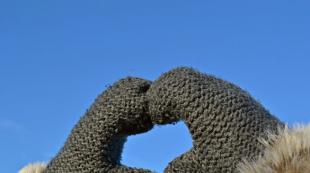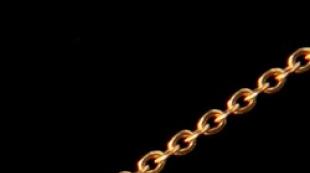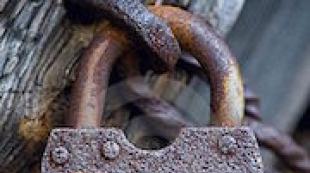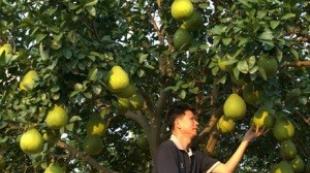Mk imitation wood "honey barrel". Amazing paper barrel. A simple master class on how to make a paper barrel
Bondar is a rare profession. Products made of glass, metal, and synthetics have finally replaced the tub, tub, and kneading bowl from our homes. But the barrel and the tub are still indispensable.
What can be compared to, for example, a cucumber or a tomato pickled in an oak tub? And in a linden barrel, honey and apple juice are perfectly stored, and you can make kvass in it. Finally, an oak tub with a lemon or laurel tree today will not spoil the interior of even a city apartment. You just can’t find these simple products either in the store or on the market. But you can do it yourself, and although this task is not an easy one, an amateur craftsman is quite capable of handling it.
RIVETS
First of all, you need to choose wood. Oak and pine are not suitable for storing honey - honey darkens in an oak barrel, and smells of resin in a pine barrel. Here we need linden, aspen, plane tree. Poplar, willow, and alder will also do. But for pickling, pickling or soaking, there is nothing better than oak - such a barrel will last for decades. For other needs, you can use sedge, beech, spruce, fir, pine, cedar, larch and even birch.
Usually the lower part of the trunk of old trees is used for rivets; it is called “riveter”. But a tinkerer will choose blanks from ordinary firewood and adapt a thin trunk to the job. It is best to make rivets from raw wood. First, the log - it should be 5-6 cm longer than the future stave - is split in half, gently tapping the log on the butt of the ax. Each half is then again split into two parts and so on, depending on the thickness of the chock (Fig. 1), to ultimately obtain blanks 5-10 cm wide (for sweet clover - 15 cm) and 2.5-3 cm thick. You need Just try to ensure that the split goes radially - this will protect the riveting from cracking in the future.
The chopped pieces are dried in a room with natural ventilation for at least a month. To speed up the process, you can use a dryer. The dried workpiece is processed with a plow or sherhebel and a plane. First, the outer surface of the riveting is planed. In this case, to check the curvature of the surface, you should make a template in advance (Fig. 2), cutting it out of a thin board according to the finished product. Next, the side surfaces are planed, also checking their curvature against the template.
Riveting can be tubular - in which one end is wider than the other, and barrel - with an expansion in the middle. The magnitude of these expansions determines the taper of the tub and the convexity of the central part of the barrel. It is enough if the ratio between the widest and narrowest part of the riveting is 1.7-1.8 (Fig. 3).
Processing of the side surface is completed by jointing. It is more convenient to do this by moving the workpiece along the jointer (Fig. 4). At the next stage, we process the internal (in relation to the finished barrel) surface of the stave, cutting off excess wood with a plane or even an ax (Fig. 5). After this, the barrel stave can be considered ready, but the barrel stave still needs to be thinned to 12-15 mm in the middle (Fig. 6). Don't be confused by the fact that the rivets can have different widths - we take the best we can from each workpiece.
HOOPS
Barrel hoops are made of wood or steel. Wooden ones are not so durable, and they are a hundred times more hassle, so it is better to use steel ones. The hoops are made from hot-rolled steel strip with a thickness of 1.6-2.0 mm and a width of 30-50 mm.
Having measured the barrel at the place where the hoop is tensioned, we add double the width of the strip to this size. Using a hammer, we bend the workpiece into a ring, punch or drill holes and install rivets made of soft steel wire with a diameter of 4-5 mm (Fig. 7). One inner edge of the hoop must be flared by striking the pointed end of a hammer on a massive steel stand (Fig. 8).

Based on their location on the product, hoops are distinguished into a bunch hoop - a central hoop on a barrel, a morning hoop - an outer hoop, and a neck hoop - an intermediate hoop.
ASSEMBLY
A grandmother brought a crumbling tub to a handyman with a request to put it back together. Tom had never had to do this before, but he did not refuse the old woman. I came up with the following: I threw a rope on the floor and laid out rivets on it one after the other. Then he pressed them down with pillows and pulled the ends of the rope together. Gradually removing the pillows, I brought the outer rivets together and secured them with a hoop.
Coopers make it easier.
The product is assembled on any flat surface. First, two rivets are attached to the hoop opposite each other with special brackets bent from hoop iron (Fig. 9). Then, by attaching rivets to one of them, we will get to the other, which will press the assembled half of the barrel. Continue assembling until the rivets fill the entire perimeter of the hoop.
Lightly tapping the hoop with a hammer, we set it down and check whether the edges of the rivets meet tightly. To achieve contact between the rivets over the entire side surface, you need to add a rivet or pull out an extra one and then install a permanent hoop. By the way, if changing the number of rivets does not give the desired effect, you just need to narrow one of the rivets or replace the narrow one with a wider one.
Having leveled the ends of the frame with light blows of a hammer, put on the middle hoop and push it until it stops using a hammer (Fig. 10).
Having placed the frame on a flat surface, we describe the cut line with a pencil using a block (Fig. 11). Having installed the morning hoop, we cut off the frame 2-3 mm from it and clean the ends of the rivets with a plane. We do the same with the other end of the frame.
When making a keg, after attaching the onion, neck and morning hoop on one side, the other side must first be tightened. Coopers have a special device for this - a yoke. A home craftsman can use a cable, rope, chain or wire for the same purposes. You can tie a noose and gag it, or tighten the ends of the cable with a lever (Fig. 12).
There is no need to steam or boil the core, as some experts recommend, before tightening. Occasionally, however, it happens that the riveting does not bend along its entire length, but in one place and therefore cracks. However, in such cases the cooper will prefer to simply make a new stave.
DONYA
The assembled frame is cleaned from the inside with a plane or sherhebel, and the ends of the frame are cleaned with a planer - a humpback (Fig. 13).
Now you need the skeleton (Fig. 14). The cutter of the tool can be made from hoop iron, or even better, from a saw blade. The depth and width of the groove should be 3 mm (Figure 15).
First, a bottom shield is assembled from a sweet clover with a planed outer side and jointed side surfaces (Fig. 16). The clover is fastened with nails, as shown in the figure, for which nests 15-20 mm deep are pre-drilled. The radius of the future bottom is found as the side of a regular hexagon inscribed in the circle of the morning groove on the frame of the barrel. However, you need to cut out the bottom with a margin, departing from the intended circle by 1 - 1.5 mm. After cleaning with Sherhebel, chamfers are cut from the edge of the bottom (Fig. 17) so that three millimeters from the edge the thickness of the wood is 3 mm - this is necessary for the tightness of the connection between the bottom and the frame in the morning groove (Fig. 18).
We do the first fitting - having loosened the hoop, we put in the bottom, inserting one side of it into the groove, and then lightly hitting the rest of it with a hammer. If the bottom is tight, you need to further loosen the hoop, and if it is too loose, tighten it.
After stuffing the hoop, make sure there are no gaps. An ideal result is rarely achieved the first time. Even if the cracks are not visible to the eye, you can find them by pouring a little water into the barrel. If it flows between the rivets, it means the bottom is too big and needs to be slightly planed. It's worse if water leaks through the bottom or through the mouth groove. Then you will have to disassemble the frame and narrow one of the rivets.
Before installing the second. At the bottom, a filling hole with a diameter of 30-32 mm should be drilled in it. The plug is made as shown in Fig. 19, its height must be no less than the thickness of the bottom, but the plug must not protrude beyond the plane of the frame edge.
HOW LONG DOES THE BARREL SERVE?
First of all, it depends on the operating conditions. But it is important to remember that you should not paint filling containers with oil paint: it clogs the pores, which contributes to the rotting of the wood. It is advisable to paint the hoops - they will not rust. For decorative purposes, a barrel or flower tub can be treated with mordants.
The brown color of oak is given by slaked lime mixed with a 25% ammonia solution. A black solution of iron sulfate or an infusion of iron filings in vinegar for 5-6 days.
A decoction of the rhizomes of woodruff (Asperula odorata) colors linden and aspen red. The red-brown color comes from a decoction of onion peels, and the brown color comes from a decoction of walnut fruit. These dyes are both brighter than chemical ones and more stable.
It is also important to remember that wood is better preserved at constant humidity. Therefore, dry containers should always be kept dry, and bulk products filled with liquid. Both of them cannot be placed directly on the ground. It is better to place a brick or plank under the barrel than to subsequently get rid of rot by cutting the chimes.
But no matter how long a barrel made with your own hands serves, all this time it will be a pleasant reminder to the owner of the difficulties overcome in understanding the secrets of the ancient craft of a cooper.
For the New Year's party, the youngest son had to make a “barrel of honey” in addition to the bear costume. To do this, we used an empty plastic water bottle, which we painted the inside yellow. Surface painting experts say that it would be better to use acrylic paint, but we limited ourselves to gouache and PVA glue. In the photo, our “barrel” is in the center. 

So, empty the plastic bottle of water and let it dry. In a separate bowl, mix yellow gouache and PVA glue in approximately equal volumes. 
For us, 2 full tbsp was enough to color a liter bottle. spoons of paint and 4 tbsp. l. glue, since glue cannot be heaped into a spoon. The finished mixture must have fluidity so that it can be distributed over the inner surface of the bottle, and be viscous enough so that it does not immediately flow down the walls to the bottom.
The prepared mixture for coloring was poured into a bottle, closed with a lid and evenly distributed over the inner surface of the bottle. Without removing the lid, we left the bottle for several hours at room temperature. If you remove the cover, the paint will dry faster, but dried-on defects will be more difficult to remove.
Attention! You cannot place a bottle on a battery, because even with slight heating, the paint quickly drains and stains form on the walls of the bottle.
After a few hours, the bottle was again rotated slightly in different directions in order to mask the defects that had formed with the still liquid paint. Remove the lid for 15-20 minutes to ventilate the internal volume of the bottle. The cap was screwed back on and the bottle was left to dry for a few more hours. The mixture of glue and paint gradually thickens and loses its fluidity. 
On the outer surface of the painted bottle, you can write the word “Honey” with a felt-tip pen. A children's craft from a plastic bottle is ready.
Amazing paper barrel. Simple master class
We will need:
1. beer cardboard (white, not the thickest)
2. glue "Moment Crystal"
3. watercolor paints
5. scrap paper
6. flowers and decorations to your taste
We cut out a round bottom from beer cardboard (mine is 13.5 cm in diameter) and cut into strips. For a diameter like mine, I cut it 1.5 cm wide and 10 cm high.

Next, from paper (I took it for graphic work, it can be used for drawing, the main thing is not too thin) we cut out a strip 42 cm long - this is exactly the width of an A3 sheet, it was just enough for me. The height can be calculated as follows: 10 cm - bottom height + 2-3 cm. At a distance of these 2-3 cm we crease and cut into triangles, as in the photo.


I secured the joint with a piece of regular tape.

We glue our stripes around the perimeter.

We cut out two strips from beer cardboard (these will be our rims on the tub) 1.5 cm wide and approximately 44.5 cm long (it’s better to take extra and cut off the excess later).

Here is a nuance: my beer cardboard is quite thin and bends very well. If yours is thick, then you need to moisten it a little and wrap it around the box, and hold it there until it dries so that it takes shape.
To give it an aged look, paint over the distance between the stripes with black. I used regular watercolor paints.
Then we cover it with white primer or acrylic paint.

We tint it with blue paint, or whatever you like best)))) I tried to do the opposite on one part - first paint it with blue paint, and then with primer. I liked both options.
We also paint stripes.
Leave to dry.
When everything is dry, glue the strips in a circle.

From paper we cut out a circle with a diameter 1 mm smaller than our bottom and two strips 21 cm long and 10 cm wide (height of the barrel), glue everything inside.
You can leave it as is, or you can decorate it to your taste. I decorated with flowers))

MK Imitation wood, glaze. "Gift Barrel for Honey"
1. We will need two plates of different sizes (the difference should not be very large, about one and a half to two centimeters) and a container that will then be located inside the gift barrel;

2. We will need corrugated cardboard. We cut out circles from corrugated cardboard: 1 circle - large (within which we cut out a circle for further gift packaging) Trace the gift along the most protruding part and then be sure to try it on, and if our gift hardly fits into the hole, enlarge it a little. 2 circles of smaller diameter with holes inside and 1 circle of smaller diameter without inner hole. We will also need 1 circle of thin cardboard (whatman paper can be used), but its internal hole should be 1-2 mm narrower than the other internal holes;

3. In order not to have to worry about calculations, I took a flexible centimeter and measured the circumference of our circles. The larger one turned out to be 52 cm and the smaller one was 46.

4. We need to determine how many centimeters in height the barrel will be (the height of the gift + the bottom and top of the barrel), I added 2 cm at the top and bottom (4 cm in total)
We also need to determine how many cm in length we should make the pattern of the barrels. Our barrel will consist of two canvases. Since our largest circle is 52 cm in circumference, we boldly add 3 cm, and maybe even 4 cm. (Depends on the thickness of the cardboard - the thicker it is, the more centimeters it will eat). The first half of the barrel is larger than the second, look at your box (how long it is). Our first ring will be located in the middle of the barrel and on the canvas we look for the middle, draw a straight line and from it another 2.5 - 3 cm up and down we draw lines (we get a strip of 5-6 cm. In the middle of this strip we will glue a larger circle)! !! The cardboard has corrugated grooves; they should run vertically. Next, we need to knead 5 centimeter-thick strips along these grooves (hereinafter the boards of our barrel) and since circles of smaller diameters will be at the top and bottom, we make darts like on a skirt (we cut along the fold line of each future board and cut to the mark that we we did it by measuring the middle) Cut to the mark closest to the edge and cut out the dart (you should get a triangle);

5. On the smaller half of the barrel we do the same.

6. This way the larger circle will be located in the middle;

7. Cut out strips 1 cm * 2-2.5 cm.

8. Glue with glue;

9. Those places where we made darts on the sides of the barrel (on two halves) - crumple with our fingers and round off from the mark where the darts end (we do not take into account the area where the large circle will be located, we only round off the tops and bottom), glue the strips onto the circles made of corrugated cardboard with holes. The following are left without stripes: a circle without a hole made of HA and a circle with a hole made of thin cardboard.

We glue our circles with holes: two smaller circles down and up (departing from the edges approximately 1 cm.) The glue is not super fast and you have to squeeze hard to get it to stick. You can tie them with elastic bands or strings of any kind to, let’s say, tighten our circles to the maximum.

While the glue dries, let's work on the lid:
We cut off the smaller circle, which is intended for the lid, a little along the edge so that the lid is flush with the top of the barrel.

We cut out 6 strips: 4 smaller and 2 larger, try them on the lid;

glue two strips together;

We glue two more smaller circles to the top circle;

The two bottom circles should be less than the top by a maximum of 1 cm. Try the bottom circles on the barrel so that they fit completely and lie on the top circle of the barrel, the circle with the hole.

We cover the finished lid and the element with which we will open it later with yacht varnish.

We treat all holes and irregularities with papier mache, sand, putty, sand again, cover with yacht varnish, glaze... see further.

We choose where our barrel will have the top and pour glue into the corrugated grooves and begin to crumple the cardboard, gluing the upper and lower parts between which the grooves are located (there should be the effect of thin cardboard.) If the three parts that make up the GC are separated, then we glue them very well to avoid air bubbles in the future. If we have air bubbles, our putty will fly around. To the bottom of the barrel, to the bottom circle with a hole, glue a circle without a hole.
While the first strip is being glued, you can apply glue to the second. While it dries on the last board, glue the previous one.

You can help yourself and clamp the tops with something while they are glued (either with clamps or clothespins, just be careful so that the clamps do not stick to the barrel),

After we have everything glued, we varnish the outside of our entire barrel thoroughly with yacht varnish.

Prepare papier mache mixture. We cut the napkins into small pieces and fill them with PVA; it is better to take a larger container;

We cover all the holes with papier mache solution, remove the excess with a cloth. When the solution dries it will be difficult to sand. The remaining solution will go to the bottom of the barrel;

This is what the barrel and lid with holder look like, treated with papier mache.

After drying, we sand the entire product and apply putty, smoothing out all the unevenness. Don't forget to apply putty to the bottom and level it with a spatula.

We also apply putty to the lid and holder;

We take a spatula and at an angle of 45 degrees we begin to draw our tree, all the knots and grooves;

After the putty has dried, we take sandpaper and clean everything up. We align everything. We coat all places with putty with yacht varnish. The putty will yellow slightly from the varnish.

Next, we need to think about the internal state of our barrel. We take whatman paper and roll it into a tube, coat our holes in the circles with glue, insert whatman paper and glue it to the sides of the holes in the circles;

We make notches on the top of the Whatman paper with scissors, bend it and cut off the excess. Glue the folded parts to the top circle of HA;

On top we glue a circle of thin cardboard with an internal hole slightly smaller than the circles made of GC. , We coat the top and the Whatman paper tube with yacht varnish;

After the varnish has dried, we cover all the cracks with putty, then again with yacht varnish, wait for it to dry;

We prepare brushes, a cloth and paints for glazing. “Tair” paints brown, white and gray, ocher; "Plaid" 915;

Mix gray “Tair” and brown “Plaid” 915 paints and apply the first layer, wait for drying;

Do not forget to paint the lid along with the barrel to avoid discrepancies in color;

We added splashes of Tair ocher, bleached the dark brown a little to light brown and sprinkled it further, then we applied dark splashes - take gray paint and apply it with some water on top, giving the effect of dusty antiquity. Next, we play with color;

Don’t forget to apply all layers to the barrel lid. After we achieve the desired result and are satisfied with it, we put brown dots on the lid, near the holder, imitating carnations;

After all the layers of paint have dried, we can coat the barrel with the finishing varnish in one layer, I use “Technolog” varnish. Next, after the varnish has dried, we begin to draw the boards. To make our barrel more like a real one, we will draw small triangles on the edges of the lines, imitating cracks;

We also draw boards on the lid;

We draw our knots with brown paint, highlight all the grooves or those that we want to highlight;


Since our barrel tapers towards the bottom and towards the top, we will need to make a pattern for our hoops first from paper, cut thin strips and equip ourselves with double-sided tape.
We remember where our pattern will begin and begin measuring in small pieces. For convenience, the beginning of the pattern can be glued to the barrel with a small piece of tape. We make sure that the strip runs straight along the top; as soon as it starts to go down, we tear it off and glue the next strip onto double-sided tape so that it runs evenly. Leave an overlap.

This is the curved pattern we got. We put notches where the beginning is and mark the top. We turn the barrel over and use the same pattern to make a pattern;

We cut off the top and bottom of the tin can, cut it lengthwise to form a rectangle, and cut off any unevenness for safety reasons!!! For convenience, we will paste several small strips of double-sided tape onto the paper pattern and place it on a tin can. We also glue a piece of tape to the edge of the tin pattern and glue a tin piece to it, continuing the pattern...

We clean the resulting tin pattern from the paint layer, do not remove the paper pattern yet.

Those places where we were fastened with tape (tin to gesture) we will need to connect them;

To do this, we take either an awl or a tailor's needle (a thick needle) and make two holes at the joints, helping with either a hammer or heavy pliers. Be sure to place an unnecessary magazine so as not to spoil the table. We try on the rings to the barrel and close them with pieces of wire. We bend the wire in the shape of the letter P and clamp it from the inside out like a bracket with pliers;

We take a sponge and apply brown paint to the tin using tapping movements. If you decide to make a pattern (squeeze out) on the tin, then use bitumen varnish rather than paint (it will show all the patterns, but there is a drawback - it smells terrible)

We process both rings and wait for drying;

We remove the paper pattern, remove the tape with a napkin or cloth, use coarse sandpaper to go over the rings for better adhesion to the glue, glue the hoops and pull them onto the barrel, pressing so that they stick. If the glue doesn’t work, then you need to take a hot gun. Next we coat it with finishing varnish and apply decoupage.

If you are interested, I have a video of MK.

We will need two plates of different sizes (the difference should not be very large, about one and a half to two centimeters) and a container that will then be located inside the gift barrel;

We will need corrugated cardboard. We cut out circles from corrugated cardboard: 1 circle - large (within which we cut out a circle for further gift packaging) Trace the gift along the most protruding part and then be sure to try it on, and if our gift hardly fits into the hole, enlarge it a little. 2 circles of smaller diameter with holes inside and 1 circle of smaller diameter without inner hole. We will also need 1 circle of thin cardboard (whatman paper can be used), but its internal hole should be 1-2 mm narrower than the other internal holes;

In order not to have to worry about calculations, I took a flexible centimeter and measured the circumference of our circles. The larger one turned out to be 52 cm and the smaller one was 46.

We need to determine how many centimeters in height the barrel will be (the height of the gift + the bottom and top of the barrel), I added 2 cm at the top and bottom (4 cm in total)
We also need to determine how many cm in length we should make the pattern of the barrels. Our barrel will consist of two canvases. Since our largest circle is 52 cm in circumference, we boldly add 3 cm, and maybe even 4 cm. (Depends on the thickness of the cardboard - the thicker it is, the more centimeters it will eat). The first half of the barrel is larger than the second, look at your box (how long it is). Our first ring will be located in the middle of the barrel and on the canvas we look for the middle, outline a straight line and from it another 2.5 - 3 cm up and down we draw lines (we get a strip of 5-6 cm. In the middle of this strip we will glue a larger circle)! !! The cardboard has corrugated grooves; they should run vertically. Next, we need to knead 5 centimeter-thick strips along these grooves (hereinafter referred to as the boards of our barrel) and since circles of smaller diameters will be at the top and bottom, we make grooves like on a skirt (we cut along the fold line of each future board and cut to the mark that we we did it by measuring the middle) We cut to the mark closest to the edge and cut out an undercut (it should turn out to be a triangle);

We do the same on the smaller half of the barrel.

This way the larger circle will be located in the middle;

Cut out strips 1 cm * 2-2.5 cm.

Glue with glue;

Those places where we made grooves on the sides of the barrel (on two halves) - crumple them with our fingers and round them off from the mark where the grooves end (we don’t take into account the area where the large circle will be located, we only round off the tops and bottom), glue the strips onto the corrugated cardboard circles with holes. The following are left without stripes: a circle without a hole made of HA and a circle with a hole made of thin cardboard.

We glue our circles with holes: two smaller circles down and up (departing from the edges approximately 1 cm.) The glue is not super fast and you have to squeeze hard to get it to stick. You can tie them with elastic bands or strings of any kind to, let’s say, tighten our circles to the maximum.
While the glue dries, let's work on the lid:

We cut off the smaller circle, which is intended for the lid, a little along the edge so that the lid is flush with the top of the barrel.

We cut out 6 strips: 4 smaller and 2 larger, try them on the lid;

glue two strips together;

We glue two more smaller circles to the top circle;

The two bottom circles should be less than the top by a maximum of 1 cm. Try the bottom circles on the barrel so that they fit completely and lie on the top circle of the barrel, the circle with the hole.

We cover the finished lid and the element with which we will open it later with yacht varnish.

We treat all holes and irregularities with papier mache, sand, putty, sand again, cover with yacht varnish, glaze... see further.

We choose where our barrel will have the top and pour glue into the corrugated grooves and begin to crumple the cardboard, gluing the upper and lower parts between which the grooves are located (there should be the effect of thin cardboard.) If the three parts that make up the GC are separated, then we glue them very well to avoid air bubbles in the future. If we have air bubbles, our putty will fly around. To the bottom of the barrel, to the bottom circle with a hole, glue a circle without a hole.
While the first strip is being glued, you can apply glue to the second. While it dries on the last board, glue the previous one.

You can help yourself and clamp the tops with something while they are glued (either with clamps or clothespins, just be careful so that the clamps do not stick to the barrel),

After we have everything glued, we varnish the outside of our entire barrel thoroughly with yacht varnish.

Prepare papier mache mixture. We cut the napkins into small pieces and fill them with PVA; it is better to take a larger container;

We cover all the holes with papier mache solution, remove the excess with a cloth. When the solution dries it will be difficult to sand. The remaining solution will go to the bottom of the barrel;

This is what the barrel and lid with holder look like, treated with papier mache.

After drying, we sand the entire product and apply putty, smoothing out all the unevenness. Don't forget to apply putty to the bottom and level it with a spatula.

We also apply putty to the lid and holder;

We take a spatula and at an angle of 45 degrees we begin to draw our tree, all the knots and grooves;

After the putty has dried, we take sandpaper and clean everything up. We align everything. We coat all places with putty with yacht varnish. The putty will yellow slightly from the varnish.

Next, we need to think about the internal state of our barrel. We take whatman paper and roll it into a tube, coat our holes in the circles with glue, insert whatman paper and glue it to the sides of the holes in the circles;

We make notches on the top of the Whatman paper with scissors, bend it and cut off the excess. Glue the folded parts to the top circle of HA;

On top we glue a circle of thin cardboard with an internal hole slightly smaller than the circles made of GC. , We coat the top and whatman paper - tube with yacht varnish;

After the varnish has dried, we cover all the cracks with putty, then again with yacht varnish, wait for it to dry;

We prepare brushes, a cloth and paints for glazing. “Tair” paints brown, white and gray, ocher; "Plaid" 915;

Mix gray “Tair” and brown “Plaid” 915 paints and apply the first layer, wait for drying;

Do not forget to paint the lid along with the barrel to avoid discrepancies in color;

We added splashes of Tair ocher, bleached the dark brown a little to light brown and sprinkled it further, then we applied dark splashes - take gray paint and apply it with some water on top, giving the effect of dusty antiquity. Next, we play with color;

Don’t forget to apply all layers to the barrel lid. After we achieve the desired result and are satisfied with it, we put brown dots on the lid, near the holder, imitating carnations;

After all the layers of paint have dried, we can coat the barrel with the finishing varnish in one layer, I use “Technolog” varnish. Next, after the varnish has dried, we begin to draw the boards. To make our barrel more like a real one, we will draw small triangles on the edges of the lines, imitating cracks;

We also draw boards on the lid;


We draw our knots with brown paint, highlight all the grooves or those that we want to highlight;

Since our barrel tapers towards the bottom and towards the top, we will need to make a pattern for our hoops first from paper, cut thin strips and equip ourselves with double-sided tape.
We remember where our pattern will begin and begin measuring in small pieces. For convenience, the beginning of the pattern can be glued to the barrel with a small piece of tape. We make sure that the strip runs evenly along the top; as soon as it starts to go down, we tear it off and glue the next strip onto double-sided tape so that it runs evenly. Leave an overlap.

This is the curved pattern we got. We put notches where the beginning is and mark the top. We turn the barrel over and use the same pattern to make a pattern;

We cut off the top and bottom of the tin can, cut it lengthwise to form a rectangle, and cut off any unevenness for safety reasons!!! For convenience, we will paste several small strips of double-sided tape onto the paper pattern and place it on a tin can. We also glue a piece of tape to the edge of the tin pattern and glue a tin piece to it, continuing the pattern...

We clean the resulting tin pattern from the paint layer, do not remove the paper pattern yet.

Those places where we were fastened with tape (tin to gesture) we will need to connect them;

To do this, we take either an awl or a tailor's needle (a thick needle) and make two holes at the joints, helping with either a hammer or heavy pliers. Be sure to place an unnecessary magazine so as not to spoil the table. We try on the rings to the barrel and close them with pieces of wire. We bend the wire in the shape of the letter P and clamp it from the inside out like a bracket with pliers;

We take a sponge and apply brown paint to the tin using tapping movements. If you decide to make a pattern (squeeze) on the tin, then use bitumen varnish rather than paint (it will show all the patterns, but there is a drawback - it smells terrible)

We process both rings and wait for drying;

We remove the paper pattern, remove the tape with a napkin or cloth, use coarse sandpaper to go over the rings for better adhesion to the glue, glue the hoops and pull them onto the barrel, pressing so that they stick. If the glue doesn’t work, then you need to take a hot gun. Next we coat it with finishing varnish and apply decoupage.
If you are interested, I have a video of MK.
Comments
| Elena Milovanova (March 21, 2014 at 8:31): | ||
Olga, it seems like a very interesting and useful MK, thanks for posting! I write “it feels” because it’s quite difficult to see everything in detail; the photos are too small, unfortunately. The end result pleased me as far as I can tell - it turned out very realistic! And yes, I would like to see the video |
||
| Olga Myagkova (March 21, 2014 at 23:33): | |
Irina, thank you very much! | |









